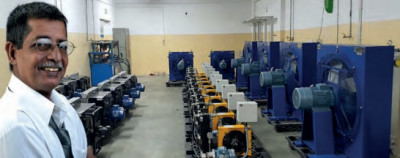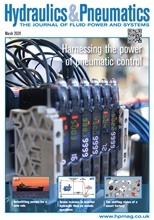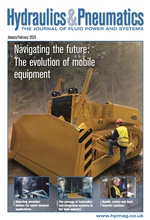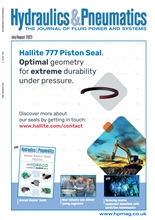- Home » Editorial » Hydraulics
Heat exchangers – Water-cooled or air-cooled?

By Vineet Taneja, CEO, Ace Automation Engineers.
One of the most common questions I am asked at training sessions and in sales meetings with clients is “Which is better – air-cooled or water-cooled?” The simple answer is that an adequately designed heat exchanger – be it water-cooled or air-cooled – is capable of removing the desired amount of heat. In my 30 years as a practicing industrial hydraulics engineer, I have used both extensively. To truly answer this question, we need to understand the basics and dig deeper.
Why do machines heat up?
No energy-consuming machine or system is 100% efficient. Though most of the energy consumed by a machine is used to do useful work, a part of the energy gets converted into heat. If this heat is not managed properly, the temperature of the equipment keeps increasing till it overheats. This causes irreparable damage, which in turn reduces efficiency further. The result is increased power consumption, reduced equipment life, breakdowns and increased maintenance costs.
To help in managing the heat generated, most equipment – hydraulic systems, gearboxes, spindles, large electrical transformers, engines, compressors, turbines, vacuum pumps, generators, blowers – use industrial oils and coolants to lubricate, cool and keep the temperatures in check.
This is done using heat exchangers or oil coolers. Oil coolers are used to cool these fluids by passing them over a cooler fluid, separated by a barrier to prevent intermixing. They remove excess heat generated by energy losses in a system. In fact, oil coolers are essential for designing temperature-optimized machines or systems that keep oil temperatures within a limited range. They are basic prerequisites for cost-efficient operation, as they provide a number of performance enhancing, economic, and environmental benefits.
In industry, various types of cooling media are used to transfer heat from cooling oils and lubricants e.g. water, air, refrigerants and hydrogen. Of these, we will discuss primarily the two types of cooling media that are most commonly used and readily available, with a relatively low cost viz. air and water.
Air-cooled oil/fluid coolers
In air cooled oil coolers the hot oil or fluid is passed in close proximity to a blast of ambient air. The heat exchange takes place across a barrier between the hot oil and cool ambient air.
There are predominantly two types of air-cooled coolers. tube fin-type and plate fin-type air-cooled oil coolers. Hot fluid enters the heat exchanger through an inlet header or tank via the inlet port. From the inlet header it is distributed through round or rectangular tubes, where the heat dissipation takes place. The cooled fluid is then collected in an outlet manifold called the outlet header or tank, finally exiting through the outlet port.
Tube-fin oil coolers
These are usually tubes with fins on the outer surface. The hot fluid flows through the round tubes transferring heat to the tube wall which in turn transfers heat to the fins attached to the outer surface of the tube. The fins are cooled by a draft of forced air. This type of oil cooler generally has low heat dissipation per unit volume of the heat exchanger. The primary reasons for this is due to low fin density, lack of turbulence inside the tube and through the fins.
Plate-fin oil coolers
Plate fin coolers use a number of rectangular tubes. These rectangular tubes are fabricated by brazing together aluminum alloy plates (also known as separator plates), sidebars and inside bars. The oil to be cooled flows in through an inlet header and is then distributed through these rectangular tubes.
Enclosed inside these rectangular tubes are fins called internal fins or internal turbulators. The heat is transferred from the oil to the internal fins. These fins play a very important role in the heat dissipation process. For one, there is a larger surface area available for heat transfer and secondly the fins cause turbulence in the oil thereby resulting in greater transfer of heat from the oil to the internal fins
The heat is then conducted from the internal fins to the plates. Between each pair of plates are external fins or external turbulators and the heat is in turn transferred from the plates to the external fins by conduction. A draft of cool ambient air is forced through the external fins carrying away the heat. The oil cooled in the rectangular tubes then collects in the outlet header and exits the heat exchanger through the outlet port.
The external fins also serve a dual purpose of creating turbulence in the air flow and providing a larger surface area, thereby resulting in greater heat transfer. This type is often categorised as a compact heat exchanger to emphasise its relatively high heat transfer surface area to volume ratio. This and their lightweight properties make plate-fin heat exchangers an obvious choice and are widely used in many industries.
They can facilitate heat transfer even when the temperature difference between the hot fluid and the cool fluid is small. The internal and external fins besides providing an extended surface area for heat transfer also serve to increase the structural integrity of the heat exchanger and allow it to withstand higher pressures and pressure fluctuations.
Water-cooled oil coolers
In these heat exchangers, the hot oil is passed in close proximity to water and the heat exchange takes place across a barrier between the hot oil and cool cooling water. Regarding water-cooled oil/fluid coolers, there are predominantly two types: Shell and tube-type and plate-type water cooled oil coolers. The plate type is again available in two types: Gasket platetype water cooled oil cooler, and brazed plate-type water-cooled oil cooler.
The hot and cool fluids enter the heat exchanger through respective inlet ports. After the heat exchange takes place across a barrier separating the two fluids, the fluids exit the heat exchanger through the outlet ports. For example, a shell and tube heat exchanger is comprised of a tube bundle encased in an outer housing or shell. The cool fluid usually travels through the tubes & the hot fluid moves in the shell. The heat exchange takes place across the tube surface.
In the plate type oil coolers, the gasket plate, as the name suggests, consists of alternating layers of gaskets and plates bolted together. The brazed-plate type is similar in construction except that the plates are brazed together in a vacuum furnace. The primary advantages of brazed plate-type over gasket plate alternatives are that the chance of intermixing of the fluids due to a damaged gasket is minimised and they can handle higher working pressures. In both these types, the hot and cool fluids flow in between alternating plates.
Comparative analysis between water- and air-cooled oil coolers
Now that we understand the basics, let’s take a closer look. In a water-based oil cooling system, the hot oil from the equipment is pumped through the heat exchanger. There is an exchange of heat between the hot oil and the cooling water. The cooled oil is returned back to the oil sump or reservoir. The water after it has performed its function of removing the heat from the oil, is itself now warm and has lost the ability to extract more heat efficiently. What do we do with this water? In the olden days it was simply flushed away, and more fresh water was used for cooling. With growing environmental concerns coupled with the scarcity and cost of fresh water, it needs to be recirculated. For it to be effectively re-used as a cooling media, the water needs to lose the heat that it has picked up and be cool enough to be able to remove heat efficiently from the oil. For this the warm water is then pumped to a cooling tower where an air draft is used to cool it. There are two processes involved here – the cooling of oil using water, which in turn gets heated and the cooling of hot water with ambient air. As we know, no process is 100% efficient. Assuming we have two well-designed processes, each having an overall efficiency of say 80%, we have 20% loss of efficiency in each process.
In comparison if we look at an aircooled oil cooling system, we have only one process. Again, assuming we have a well-designed process with an overall efficiency of 80%, there is a direct benefit of 20% in improved efficiency while using an air-cooled oil cooling system in comparison to a water based one.
There are other important nuances that need to be considered. For instance, the cost of energy required to pump cooling water for the entire usable life of the equipment. There is also the cost of plumbing in the initial setup, coupled with the hidden cost of maintenance of the water pump and the plumbing. It is also noteworthy that the water needs to be treated to remove salts and minerals to achieve consistent heat exchange. Untreated cooling water is more often than not laden with salts and minerals. These too add their bit to a maintenance engineer’s woes. The salts and minerals present in the water deposit on the barrier between the two fluids, commonly known as scaling. Water scaling results in bad heat conduction. Therefore, the ability of the oil cooler to transfer heat reduces considerably over time, due to scaling.
Water-based oil coolers therefore need to be descaled. As the water flows through the oil cooler, salts start depositing on the surface of the tube or plate barrier between the two fluids, through which the heat is being transferred. These salt or chemical deposits called scale (usually white or offwhite in colour) build up over time. As a result, heat exchange reduces considerably. Water cooled heat exchangers therefore need to be serviced or descaled from time to time. The performance reduces with respect to usage time. The extent of loss in efficiency is dependent on the quality of water available at the site of usage. The amount and type of dissolved salts and minerals in the water determines the frequency of descaling (or servicing in case of gasket plate heat exchangers). These cost heavily, not only in terms of maintenance cost, but also the cost of gaskets/descaling chemicals, time, money and production loss due to repeated maintenance shutdowns.
Air-based oil cooling system
On the other hand, let’s look at an airbased oil cooling system. Here too there is a drop in efficiency with time, as dust and pollutants from the atmosphere deposit on the fin surface. The fins too need to be cleaned, but the cleaning process is simple and effective. A compressed air blast done regularly is enough to remove the dust build up. This cleaning can be carried out while the system is still operative and does not require a shut-down. Besides the above, an obvious advantage of an air-cooled oil cooler is that it does not require water, which means that equipment requiring cooling need not be near a cooling water connection or source.
The machine can therefore be stand-alone. Just plug in the electrical power and we are good to go. On the contrary, every time a machine with a water-based oil cooling needs to be shifted or relocated, the water supply plumbing needs to be redone. Further, the problems associated with treatment and disposal of water have become more costly with government regulations and environmental concerns. Air-cooled or air blast or fan cooled oil coolers as they are commonly called provide means of transferring the heat from the fluid directly into ambient air, without environmental concerns and at a nominal running cost.
Traditionally, water has been used for centuries as a cooling medium. However, annual water consumption in the world has reached astronomical figures. The increasing scarcity of fresh water resulted in the need for its recirculation. For it to be recirculated for cooling, the water needs to be cooled, which is done by cooling it with air. Newer technologies therefore evolved to increasingly use air directly as a cooling medium. Air-cooled systems dissipate heat with flowing air. These not only have the advantage of easy availability, higher reliability and lower running cost but are simpler to maintain. They also eliminate the problem of water contamination and minimise corrosion.
https://twitter.com/engineers_ace
https://www.linkedin.com/company/ace-automation-engineers/
-
Smart Manufacturing & Engineering Week
05 - 06 June, 2024
NEC, Birmingham -
HILLHEAD 2024
25 June, 2024, 9:00 - 27 June, 2024, 16:00
Hillhead Quarry, Buxton, Derbyshire UK










